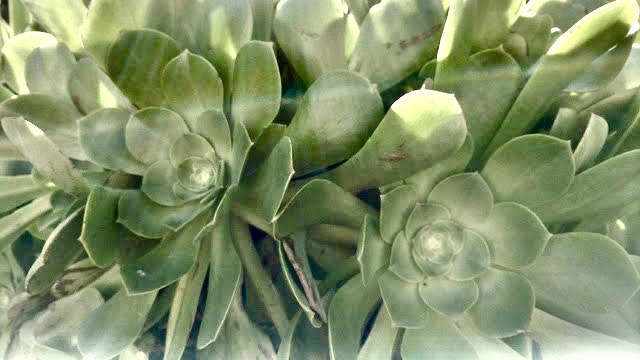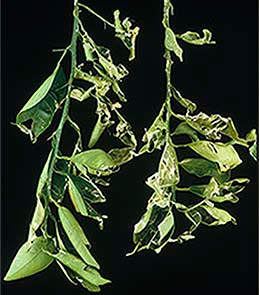
Winter weather can damage plants, particularly succulents

|
|
A hen and chicks succulent shows tiny nicks and other hail damage. (Photo: Debbie Arrington)
|
Cold and stormy weather this week has had an impact on more than traffic and holiday celebrations.
Hail can harm tender plants, particularly succulents. These fleshy favorites already were uncomfortable from too much rain and low temperatures. As for hail, it causes tiny nicks and scarring on succulents’ tender leaves or, in worse cases, beats them to a pulp.
Hail also punches holes in big tender foliage on plants such as canna or ginger. Since our winter temperatures had been mostly mild, these plants were holding onto their leaves later than usual.
But a big hailstorm also can tear up foliage on citrus and evergreen shrubs. It can damage fruit and scar the tree.
Most plants cope with winter hail OK; winter survival is a big reason so many perennials, trees and shrubs go dormant during these cold months.
Spring hail can do the most damage; it knocks tender new growth and spring blooms off fruit trees and trashes little seedlings.
According to UC master gardeners, “impact from hail can tatter leaves, cause sunken scars on the outer and upper surfaces of fruit and twigs, and increase plant susceptibility to wound-related maladies.”
Wounds occur on the side of the plant that faced the storm directly, the master gardeners say.
“Hailstones usually tatter, tear, and pit leaves and scar fruit,” they add. “If hail impacts young fruit, scars can become large and distinctive as the rind enlarges.
“Sometimes hail causes elliptical wounds in bark or breaks twigs. Large wounds can cause branches to develop cankers, become girdled, and die. Severe fire blight can occur in susceptible species shortly after hail damage causes wounds through which pathogens enter hosts.”

|
|
These citrus leaves show hail damage. (Photo courtesy
UC Integrated Pest Management)
|
In areas where hail is common, gardeners keep buckets and trash cans at the ready to use as instant hail shelters to cover tender plants. But in California’s Central Valley, hail is considered rare.
Most hail damage is cosmetic; it can be pruned off and the plant will grow back healthy.
Temperatures have been unusually cold, too. If there’s frost damage as well as hail damage, wait until March or April to prune off browned branches. That injured area will help protect the rest of the plant from further cold.
However, succulents damaged by hail and frost may not survive this cold and wet winter. Fleshy leafed plants can bruise and show lasting scars of hail impacts. In addition, succulents are filled with water. Their cells can freeze, then burst, turning the foliage to mush.
Hail usually melts before it can cause any frostlike damage, but exposure to temperatures below 32 degrees for 30 minutes or more can cause significant damage to fleshier succulents.
According to succulent experts, it’s not just the cold that causes damage, but the exposure to bright sunlight when frozen. The plants need to thaw gradually to avoid bursting their cells. Shade them with a sheet or cardboard to protect them while they thaw.
Due to an abundance of rain this winter, succulents already are at risk of rot. They can survive frosty conditions much better with dry soil than wet. If planted in containers, make sure to tip out excess water.
Because of this rot risk, prune off mushy foliage and stems from damaged succulents immediately to encourage new healthy growth. Crassulas, aeoniums, euphorbias and kalanchoes are at greatest risk.
For more on hail damage: http://ipm.ucanr.edu/PMG/GARDEN/ENVIRON/hail.html
Comments
0 comments have been posted.Sacramento Digs Gardening to your inbox.
Food in My Back Yard Series
May 6: Maintain soil moisture with mulch for garden success
April 29: What's (already) wrong with my tomato plants?
April 22: Should you stock up on fertilizer? (Yes!)
April 15: Grow culinary herbs in containers
April 8: When to plant summer vegetables
April 1: Don't be fooled by these garden myths
March 25: Fertilizer tips: How to 'feed' your vegetables for healthy growth
March 18: Time to give vegetable seedlings some more space
March 11: Ways to win the fight against weeds
March 4: Potatoes from the garden
Feb. 25: Plant a fruit tree now -- for later
Feb. 18: How to squeeze more food into less space
Feb. 11: When to plant? Consider staggering your transplants
Feb. 4: Starting in seed starting
Sites We Like
Garden Checklist for week of May 4
Enjoy this spring weather – and get gardening!
* Plant, plant, plant! It’s prime planting season in the Sacramento area. Time to set out those tomato transplants along with peppers and eggplants. Pinch off any flowers on new transplants to make them concentrate on establishing roots instead of setting premature fruit.
* Direct-seed melons, cucumbers, summer squash, corn, radishes, pumpkins and annual herbs such as basil.
* Harvest cabbage, lettuce, peas and green onions.
* In the flower garden, direct-seed sunflowers, cosmos, salvia, zinnias, marigolds, celosia and asters. (You also can transplant seedlings for many of the same flowers.)
* Plant dahlia tubers. Other perennials to set out include verbena, coreopsis, coneflower and astilbe.
* Transplant petunias, marigolds and perennial flowers such as astilbe, columbine, coneflowers, coreopsis, dahlias, rudbeckia and verbena.
* Keep an eye out for slugs, snails, earwigs and aphids that want to dine on tender new growth.
* Feed summer bloomers with a balanced fertilizer.
* For continued bloom, cut off spent flowers on roses as well as other flowering plants.
* Add mulch to the garden to maintain moisture. Mulch also cuts down on weeds. But don’t let it mound around the stems or trunks of trees or shrubs. Leave about a 6-inch to 1-foot circle to avoid crown rot or other problems.